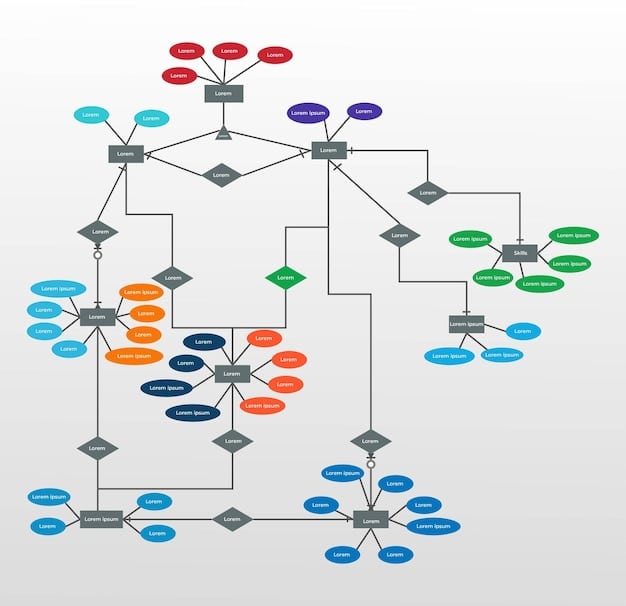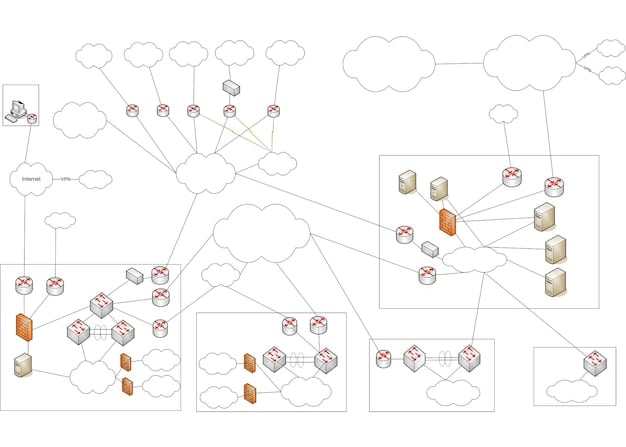Cloud-Native Application Development: A Guide for US Software Teams

Cloud-native application development is an approach to building and running applications that leverages cloud computing’s service delivery model and utilizes technologies like containers, microservices, and DevOps practices to ensure scalability, resilience, and faster time-to-market for US software teams.
Cloud-native application development represents a paradigm shift in how software is created and deployed. For US software teams, embracing this approach can unlock significant benefits, from improved scalability and resilience to faster innovation cycles. This guide provides a comprehensive overview of cloud-native development, tailored for the unique challenges and opportunities faced by teams in the United States.
Understanding Cloud-Native Application Development
Cloud-native application development is more than just moving applications to the cloud. It’s about designing and building applications specifically to take advantage of the cloud’s inherent capabilities. This means embracing a new set of architectural patterns, development practices, and operational models.
Key Principles of Cloud-Native Development
Cloud-native architectures are built on several core principles that enable agility, scalability, and resilience. Understanding these principles is crucial for any US software team embarking on a cloud-native journey.
- Microservices: Breaking down applications into small, independently deployable services.
- Containers: Packaging applications and their dependencies into standardized units for consistent execution across environments.
- DevOps: Fostering collaboration between development and operations teams to automate and streamline the software delivery process.
- Continuous Delivery: Automating the release pipeline to enable frequent and reliable deployments.
These principles, when applied effectively, empower US software teams to deliver high-quality applications faster and more efficiently. They also provide the flexibility needed to adapt to changing business requirements and scale resources on demand.

In conclusion, understanding the core principles of cloud-native development is essential for US software teams looking to modernize their applications and gain a competitive edge. By embracing microservices, containers, DevOps, and continuous delivery, teams can build and deploy applications that are more scalable, resilient, and adaptable to change.
Benefits of Cloud-Native for US Software Teams
Adopting a cloud-native approach offers a wealth of benefits for US software teams, extending beyond simple cost savings. It transforms how teams operate, innovate, and deliver value to their customers.
Enhanced Scalability and Resilience
Cloud-native applications are designed to scale horizontally, meaning they can handle increased traffic and demand by adding more instances of microservices. This inherent scalability ensures that applications can maintain performance even during peak loads.
- Automatic Scaling: Cloud platforms automatically adjust resources based on real-time demand.
- Fault Tolerance: Microservices architecture isolates failures, preventing them from cascading across the entire application.
- Geographic Redundancy: Deploying applications across multiple regions ensures availability even in the event of a regional outage.
For US businesses, this translates to reliable and responsive applications that can meet the demands of a growing user base. It also minimizes the risk of downtime, which can be costly and damaging to reputation.
In summary, the enhanced scalability and resilience offered by cloud-native architectures are crucial for US software teams aiming to deliver high-performance and reliable applications. This model ensures that applications can handle increasing demand and recover quickly from failures, minimizing disruptions and maximizing uptime.
Key Technologies in Cloud-Native Development
Cloud-native development relies on a range of technologies that work together to enable agility, scalability, and resilience. Understanding these technologies is critical for US software teams looking to build and deploy cloud-native applications.
Containers and Orchestration
Containers provide a standardized way to package applications and their dependencies, ensuring consistent execution across different environments. Kubernetes is the leading container orchestration platform, automating the deployment, scaling, and management of containerized applications.
Service Meshes
Service meshes provide a dedicated infrastructure layer for handling service-to-service communication. They offer features like traffic management, security, and observability, making it easier to manage complex microservices architectures.
- Istio: A popular open-source service mesh that provides traffic management, security, and observability features.
- Linkerd: A lightweight and simple service mesh designed for ease of use.
- Consul: A service networking solution that provides service discovery, configuration, and security features.
Choosing the right technologies for your cloud-native journey depends on your specific needs and requirements. US software teams should carefully evaluate different options and select the tools that best align with their goals.

In conclusion, the selection and effective utilization of these core technologies are crucial for US software teams implementing cloud-native strategies. By understanding and leveraging containers, orchestration tools like Kubernetes, and service meshes, teams can build robust, scalable, and manageable cloud-native applications.
Cloud-Native Development Best Practices for US Teams
Adopting cloud-native development requires more than just adopting new technologies; it also involves embracing new ways of working. US software teams should follow these best practices to maximize the benefits of cloud-native.
Automate Everything
Automation is key to achieving the agility and efficiency promised by cloud-native development. Automate everything from building and testing to deployment and monitoring. This reduces manual effort, minimizes errors, and accelerates the software delivery process.
Embrace DevOps Culture
DevOps is a cultural philosophy that emphasizes collaboration and communication between development and operations teams. By breaking down silos and fostering a shared responsibility for the entire software lifecycle, US software teams can improve efficiency and responsiveness.
- Shared Responsibility: Development and operations teams work together throughout the entire software lifecycle.
- Continuous Feedback: Implement feedback loops to identify and address issues quickly.
- Automation: Automate as much of the software delivery process as possible.
These practices help US software teams deliver high-quality software faster and more reliably. They also enable teams to adapt quickly to changing business requirements and customer needs.
In summary, embracing these best practices is essential for US software teams aiming to fully leverage the benefits of cloud-native development. By prioritizing automation, fostering a DevOps culture, and focusing on security and monitoring, teams can build and deploy cloud-native applications that are scalable, reliable, and secure.
Overcoming Challenges in Cloud-Native Adoption
While cloud-native development offers many benefits, it also presents several challenges that US software teams must address. These challenges range from technical complexities to organizational changes.
Complexity of Microservices Architectures
Microservices architectures can be complex to design, build, and manage. Breaking down applications into small, independently deployable services introduces new challenges, such as service discovery, inter-service communication, and distributed tracing.
Security Considerations
Cloud-native applications require a different approach to security. Traditional security measures are often not sufficient to protect distributed microservices architectures. US software teams must implement robust security practices at every stage of the software lifecycle, from development to deployment.
- Identity and Access Management: Implement strong authentication and authorization controls.
- Network Security: Use network policies to isolate microservices and control traffic flow.
- Data Encryption: Encrypt data at rest and in transit to protect it from unauthorized access.
For US software teams, addressing these challenges requires a combination of technical expertise, cultural change, and strategic planning. By carefully planning and implementing best practices, teams can overcome these challenges and reap the rewards of cloud-native development.
In conclusion, recognizing and addressing these challenges proactively is crucial for US software teams aiming to successfully adopt cloud-native development. By focusing on managing complexity, addressing security concerns, and navigating organizational changes, teams can overcome these hurdles and realize the full potential of cloud-native architectures.
The Future of Cloud-Native in the US Market
Cloud-native development is rapidly evolving, and US software teams must stay ahead of the curve to remain competitive. Several trends are shaping the future of cloud-native in the US market.
Serverless Computing
Serverless computing is a cloud execution model where the cloud provider dynamically manages the allocation of machine resources. Developers can focus on writing code without worrying about infrastructure management.
- Reduced Operational Overhead: Serverless platforms handle infrastructure management, allowing developers to focus on code.
- Pay-Per-Use Pricing: You only pay for the resources you consume, reducing costs during periods of low traffic.
- Automatic Scaling: Serverless platforms automatically scale resources based on demand.
Edge Computing
Edge computing brings computation and data storage closer to the devices where it is being gathered, rather than relying on a central location that could be thousands of miles away. This is crucial for applications that require low latency and real-time processing.
For US software teams, embracing these emerging trends can unlock new opportunities for innovation and growth. By staying informed and experimenting with new technologies, teams can position themselves for success in the rapidly evolving cloud-native landscape.
| Key Point | Brief Description |
|---|---|
| 🚀 Microservices | Applications broken into independently deployable services. |
| 📦 Containers | Standardized units for consistent execution across environments. |
| ⚙️ DevOps | Collaboration to automate software delivery. |
| 🛡️ Security | Implement robust practices at every stage. |
Frequently Asked Questions
Cloud-native application development is an approach to building applications that leverages cloud computing’s service model, using technologies like containers, microservices, and DevOps to enhance scalability and resilience.
Cloud-native practices can significantly enhance agility, scalability, and resilience for US software teams, enabling them to deliver high-quality applications faster and more efficiently in the competitive US market.
Key technologies include containers (like Docker), orchestration platforms (like Kubernetes), and service meshes (like Istio), all designed to manage and scale microservices-based applications effectively.
Challenges include managing the complexity of microservices, ensuring robust security across distributed systems, and adapting organizational culture to embrace DevOps principles and continuous delivery practices.
US companies can prepare by staying informed about emerging trends like serverless computing and edge computing, and by investing in training and resources to build expertise in cloud-native technologies and practices.
Conclusion
Cloud-native application development is transforming the way software is built and deployed in the US. By embracing its principles, practices, and technologies, US software teams can unlock significant benefits, including improved scalability, resilience, and faster time-to-market. While challenges exist, the rewards of cloud-native adoption are well worth the effort. As the cloud-native landscape continues to evolve, US teams must stay informed and adapt to new trends to remain competitive and innovative.





